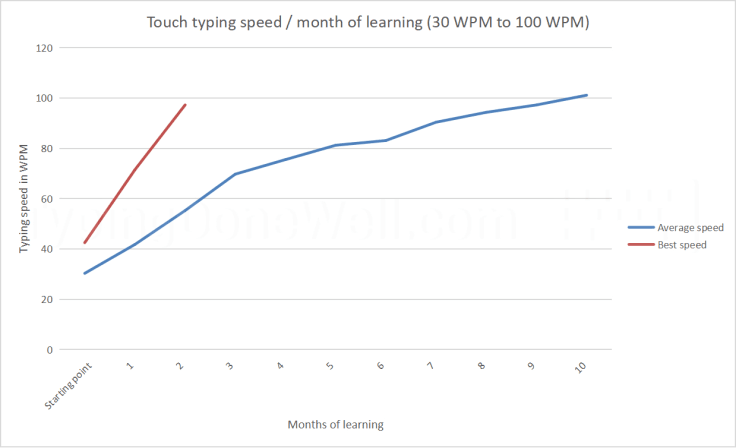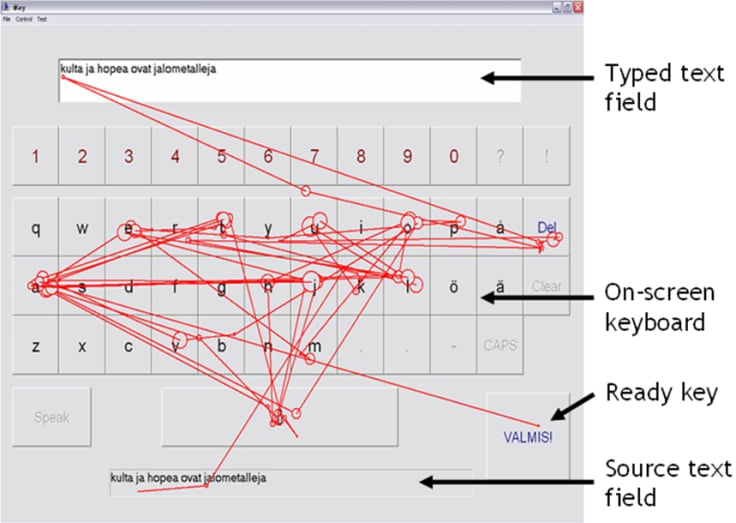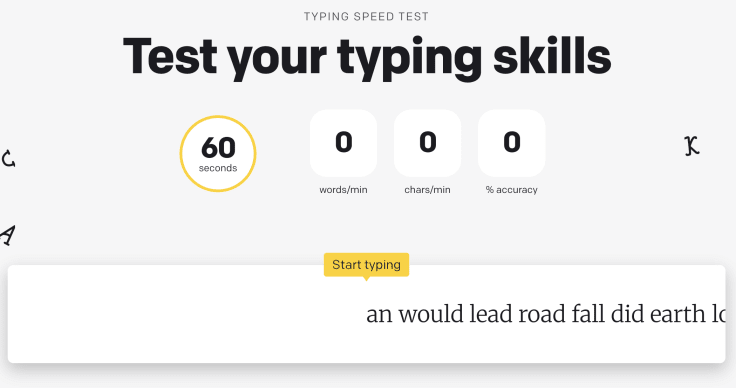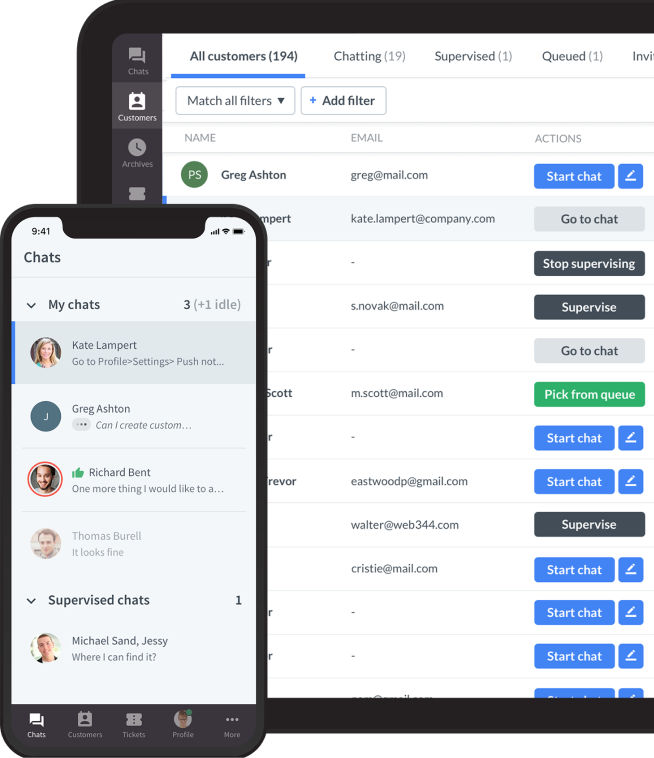
What’s a good typing speed for employees?
And how does your WPM compare to job benchmarks?
If you're answering customer messages, managing emails, or entering data, how fast you type is very important for how well you work. In roles such as customer service, live chat support, and administrative assistance, every word per minute (WPM) adds up to significant productivity gains.
The average typing speed for most adults falls around 40 WPM, but many roles benefit from much higher speeds. So what counts as a good typing speed? And where does your current WPM stand compared to job-specific benchmarks?
In this guide, you’ll learn:
- What qualifies as a good typing speed across various job roles?
- The average words-per-minute (WPM) benchmarks for different professions.
- How your typing speed can directly affect productivity and job performance.
- Actionable tips to improve your typing habits and accuracy.
- A simple way to test your current typing speed and track progress.
After reading this article, you will have a clear understanding of what constitutes a good WPM for your role and how to develop faster, more efficient typing skills.
What counts as a good typing speed?
Typing efficiently is one of the most overlooked yet critical skills in the modern workplace.
Typing speed is typically measured in words per minute (WPM), a metric that tells us how many words someone can type in 60 seconds with minimal errors.
But what’s considered a “good” typing speed? The answer depends largely on the nature of your role and how frequently you rely on typing as part of your daily responsibilities.
While many people associate fast typing with tech-savvy professionals or writers, the truth is that nearly every desk-based role involves typing to some extent. From live chat agents and professional assistants to office administrators and data entry clerks, being able to type quickly and accurately is often a silent qualifier for efficient work.
Let’s explore the benchmarks for what’s considered good typing speed in different professions, and how these numbers can help you or your team evaluate and improve day-to-day performance.

What’s a good WPM by role?
There is no universal number that defines a good typing speed for everyone. Instead, different industries and job functions come with different expectations.
Below is a breakdown of average WPM standards based on specific roles and responsibilities.
Average typist: 40–50 WPM
What is a good typing speed for an average typist? This range represents the general population, those who use a computer regularly but haven't received any formal typing instruction.
Typing at 40 to 50 WPM is usually sufficient for casual tasks such as browsing the web, writing emails, or drafting short documents. However, for jobs that require a lot of written communication or fast-paced task management, this speed may fall short. Improving your typing speed even slightly can make routine work more efficient and less mentally taxing, especially when you're typing for extended periods.
Interestingly, the average WPM across all adults in the U.S. hovers around 41–45 WPM. This means if you're in this range, you're right in line with most users, but there's room to grow, especially in a professional setting.
Office workers: around 60 WPM
In most general office roles, a typing speed of around 60 WPM is considered both practical and productive. Office workers often need to handle a range of communication tasks, from writing meeting notes and preparing reports to corresponding with clients.
A speed of 60 WPM allows them to complete these tasks efficiently without feeling rushed, helping to keep up with workflow demands and deadlines. This level of proficiency also reduces the risk of bottlenecks in administrative processes, allowing for smoother day-to-day operations.
According to studies from typing platforms like Ratatype and Typing.com, many employers set a benchmark of at least 55–70 WPM for administrative roles to ensure their employees can effectively manage high volumes of written work.
Data entry specialists: 60–80 WPM
Data entry professionals are among the fastest typists in the workplace who use extensive typing techniques. Their roles require entering large amounts of information quickly and with high accuracy, often involving long shifts spent typing repetitive data. For this reason, employers typically expect data entry clerks to maintain a typing speed between 60 and 80 WPM.
At this level, accuracy becomes just as important as speed. Typing errors can result in incorrect entries, which in turn can compromise databases or slow down operational processes. High-performing data entry specialists often supplement their speed with rigorous attention to detail, using typing software and numeric keypads to further streamline their work.
These professionals play a critical role in environments like finance, healthcare, or logistics, where data errors can be costly.
Executive assistants: 70–100 WPM
Executive assistants often operate in high-pressure environments that demand multitasking, precision, and speed. Their responsibilities might include managing schedules, preparing documents, transcribing meeting notes, and communicating on behalf of senior staff. Because of the breadth and pace of their tasks, typing speeds between 70 and 100 WPM are generally expected.
Good typing skills at this rate ensure that tasks can be completed swiftly without compromising quality. An exec assistant who can keep up with real-time conversations and quickly translate them into actionable notes or emails adds significant value to an executive’s workflow.
Faster typing speed also helps these professionals stay focused on the substance of their work rather than the mechanics of typing, allowing for better decision-making support and time management.
Customer support agents: 40+ WPM
In customer support, particularly live chat, typing speed directly affects customer satisfaction. Typing too slowly can create delays in conversation, leading to frustration for customers who expect real-time support. A minimum speed of 40 WPM is generally necessary to manage customer queries efficiently.
However, many companies prefer support agents to type closer to 50–60 WPM to ensure seamless, natural conversations without unnecessary wait times.
Typing speed isn’t the only factor in this context; accuracy and clarity are just as critical. Support agents must type correctly while remaining empathetic and clear in their responses. A typo in a technical instruction or a vague answer can increase ticket volume and decrease trust.
In this setting, a high WPM paired with consistent tone and minimal errors contributes directly to better resolution times and customer experience.
How to improve typing speed and accuracy
Improving both typing speed and precision requires more than frequent typing; it’s about purposeful, consistent practice with proper technique.
If your current typing habits involve frequent backspacing, staring down at the keyboard, or typing with just a few fingers, the good news is: it’s never too late to improve.
1. Practice daily: 15–20 minutes makes a difference
Like any skill, typing improves with regular, focused effort. Practicing for just 15 to 20 minutes a day can lead to noticeable improvements in as little as a week. Short daily sessions are more effective than long, occasional ones because they help build muscle memory gradually without causing fatigue.
Set aside time each day to do dedicated typing exercises. There are plenty of online typing tests, where you can take one- to five-minute typing tests and monitor your progress over time. Focus on both speed and precision; rushing through and accumulating errors won’t help you in the long run.
Tip: Begin with exercises using common letter patterns or high-frequency words. Over time, progress to full-sentence practice that mimics real work scenarios (like answering a customer query or drafting a meeting recap).

2. Use all ten fingers for proper finger placement
Many people develop their typing habits using two or three fingers, commonly referred to as the “hunt-and-peck” method. While this might get the job done, it’s highly inefficient for any professional environment. Learning to type with all fingers improves your speed, distributes the workload more evenly across your hands, and reduces physical strain over long typing sessions.
Start by learning the home row position, where your fingers should naturally rest: A–S–D–F for the left hand and J–K–L for the right hand. From there, each finger has designated keys it is responsible for. Once you become comfortable with finger placement, you’ll notice your typing speed increase without added mental effort.
Tip: There are free online typing tutors like Keybr, TypingClub, and Ratatype that offer structured lessons specifically designed to reinforce finger position and rhythm.

3. Avoid looking at the keyboard
One key distinction between fast, accurate typists and slower ones is the ability to type without looking down at the keyboard. This is the foundation of touch typing, and it’s built entirely on muscle memory.
By training your fingers to find the keys instinctively, you reduce the time it takes to find each letter and increase your overall typing fluidity. Looking at the keyboard breaks this pattern and slows down your progress. It can be uncomfortable at first, especially if you’ve always typed visually, but with practice, the payoff is significant.
Tip: If you're tempted to glance down, try placing a small sheet of paper or keyboard cover over your hands during practice. This will force you to rely on memory and help you break the habit faster.

4. Track your progress with tests and accuracy metrics
Improvement doesn't just come from practice; it comes from measuring progress and adapting your training. Regularly testing your WPM and accuracy percentage gives you tangible goals to work toward. Most online typing platforms provide detailed reports showing your average speed, your most frequently mistyped keys, and how your performance improves over time.
Focus on accuracy first, then increase your speed. Typing 80 WPM with 70% accuracy is less useful than typing 60 WPM with 98% accuracy. Once your error rate decreases, speed often increases naturally.
Tip: Set small milestones, such as hitting 95% accuracy at 50 WPM, before aiming for faster typing speeds. Reward yourself when you reach those goals to stay motivated.

Common typing techniques and their impact
The way you place your fingers on the keyboard and how consciously you move them can significantly impact your speed and accuracy, even your basic typing skills.
While many people learn to type improvised, the method they use matters more than they might think, especially in high-volume roles like live chat support, administrative work, or content creation.
Let’s break down the three most common typing methods and how they affect your efficiency on the job.
Touch typing
Touch typing is the most efficient and accurate typing technique available. It involves using all ten fingers and keeping them anchored to specific "home row" positions—A–S–D–F for the left hand and J–K–L–; for the right. Its primary advantage is that it allows you to type without looking at the keyboard.
This method minimizes distractions and helps maintain a smooth rhythm, which in turn reduces errors and increases typing speed. Professional typists who use the touch typing method can comfortably reach speeds of 40 to 60 WPM or more, with accuracy rates exceeding 95%. Advanced typists, including professional transcriptionists and court reporters, may even reach speeds of over 100 WPM.
This type of typing is especially valuable in roles where split-second response time matters. For example, a live chat agent who doesn’t need to look down can focus entirely on the conversation at hand, improving speed and quality of service.
Hunt-and-peck
At the opposite end of the spectrum is the hunt-and-peck method. This approach involves typing using one or two fingers, visually locating each key before pressing it. While this style may feel intuitive for beginners, it’s highly inefficient for professional use.
People who practice this method typically average just 20 to 30 WPM, and they’re much more likely to make mistakes due to frequent breaks in typing flow and repeated visual shifts between the keyboard and the screen. This also places additional strain on the neck and eyes over time, contributing to fatigue during longer typing sessions.
In roles that require speed, accuracy, and multitasking, such as customer support or data entry, hunt-and-peck typing quickly becomes a productivity bottleneck.
Hybrid typing and thumb typing
Somewhere in between lies the hybrid method. Hybrid typists typically use more than two fingers and may have partial muscle memory for frequently used keys. However, they still rely on occasional glances at the keyboard and don't always follow standardized finger placement.
While this method is more efficient than hunt-and-peck, it’s still slower and less consistent than full touch typing. Hybrid typists might reach speeds of 40 to 50 WPM, and some with strong partial memory can push into the 60–70 WPM range, but often with more errors than experienced touch typists.
The hybrid method is common among self-taught typists who’ve accumulated speed over time but never practiced formal finger placement. It's a reasonable approach for those who type frequently but don’t rely on it as a core part of their job. However, with a bit of structured training, many hybrid typists can convert to full touch typing and see immediate improvements in both speed and accuracy.
Thumb typing, common on smartphones and tablets, is a whole different story. It relies on just the thumbs and often sacrifices accuracy and speed for mobility. While it’s useful for short messages on the go, it’s far from efficient for longer tasks. Most people average around 30–40 WPM when thumb typing, and fatigue can set in quickly during extended sessions.

How your typing method affects performance
Your typing style impacts your workflow efficiency, focus, and error rate.
Here’s how these methods generally compare:
| Typing method | Average typing speed | Accuracy | Effort to learn | Long-term efficiency |
|---|---|---|---|---|
| Touch typing | 50â90+ | High | Moderate | Very High |
| Hybrid typing | 40â70 | Medium | Low to moderate | Medium |
| Hunt-and-peck | 20â30 | Low | Low | Low |
If you're looking to improve your typing speed and make your workday smoother, especially in customer support or admin roles, shifting to touch typing is one of the most effective upgrades you can make.
The impact of typing skills on productivity
Typing speed directly affects how efficiently tasks are completed in roles that rely heavily on written communication.
Faster, more accurate typing saves time and boosts service quality and operational performance.
Here's how:
- Complete chats and emails faster, freeing up time for high-priority tasks. When agents can respond to inquiries quickly, they move through conversations more efficiently, allowing them to help more customers or shift attention to complex issues that require extra care. This also minimizes backlogs and wait times.
- Make fewer mistakes, reducing time spent on corrections or rework. Typing faster often comes with improved rhythm and muscle memory, which leads to fewer typos. This means less time spent proofreading, fixing formatting errors, or retyping entire messages, especially important in customer-facing communication.
- Quicker response times help meet SLAs and improve customer satisfaction. Speed directly influences how quickly issues are acknowledged and resolved. Agents who type faster are better equipped to meet service-level agreements (SLAs) and exceed expectations, which can positively impact CSAT (Customer Satisfaction) scores.
- Enhance digital communication in remote settings where typing is the primary mode of interaction. In remote and hybrid environments, where most collaboration happens through chat or email, quick and clear typing is essential. Faster typists can keep up with real-time conversations, respond in context, and prevent delays in communication loops.
- Help managers evaluate performance, onboarding, and training needsTyping speed is a valuable metric for assessing how quickly new hires are adapting to their roles. It can reveal whether additional support or training is needed and help managers identify top performers who handle a high volume of tasks with efficiency.

Test typing speed and boost productivity at once
Typing faster and more accurately helps you get things done more efficiently. In jobs like customer support, admin, or data entry, good typing skills mean quicker replies, fewer mistakes, and better service overall. The average typing speed for most people is around 40 words per minute, but with a short daily practice session, around 15 to 20 minutes, you can boost that number significantly and make your day-to-day work a lot smoother.
To take the first step, test and track your typing performance. Typing speed tests help both individuals and teams assess their current skill level and identify areas for growth.
Most typing tests are free, take just 1–5 minutes, and show both your WPM and accuracy. Some tools even offer certifications that validate your typing proficiency, ideal for hiring or internal benchmarks.
Ready to see how you measure up? Try LiveChat’s free typing speed test! Use it to track your progress, set team benchmarks, or simply challenge yourself to type faster and with more confidence.




